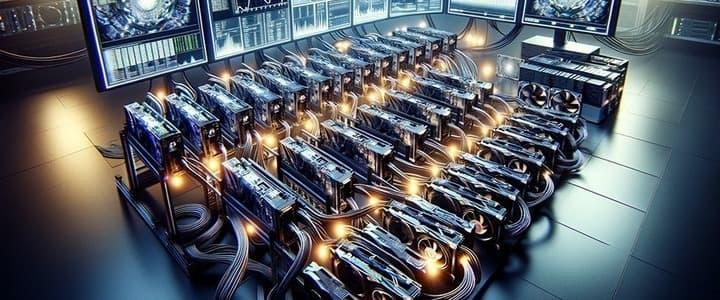Bitcoin has become one of the most popular digital currencies, and many are curious about how it works. Bitcoin mining is how new Bitcoins are created and how transactions are verified.
If you’re new to Bitcoin, the mining concept might seem confusing, but in simple terms, it’s the process that helps keep the Bitcoin network running smoothly.
This guide will explain how Bitcoin mining works, what it involves, and how you can earn it through mining.
What Is Bitcoin Mining?
BTC mining is the process of creating new Bitcoins and verifying transactions on the Bitcoin blockchain (the public ledger where all Bitcoin transactions are recorded).
It involves solving complex mathematical problems to validate and add transactions to the blockchain. To understand how Bitcoin mining works, it’s helpful to break it down into a few key steps:
Transaction Validation:
When someone sends Bitcoin to another person, the transaction must be verified and added to the blockchain.
Block Creation:
Transactions are grouped into “blocks.” These blocks are like digital “pages” of a ledger that record all the transactions made in a certain period.
Solving Cryptographic Puzzles:
These puzzles require a lot of computational power, and the first miner to solve the puzzle can add the block to the blockchain.
Reward:
As a reward for solving the puzzle and verifying the transactions, the successful miner is given newly created Bitcoins and transaction fees. This is how new Bitcoins are created and distributed to miners.

Why Is Mining Necessary?
The main goal of mining is to maintain the security and integrity of the Bitcoin network. Since Bitcoin operates without a central authority (like a bank), a system needs to verify transactions and keep the network secure.
Mining achieves this by ensuring that only valid transactions are added to the blockchain and that no one can spend the same Bitcoin twice (the “double-spending problem”).
How Does Bitcoin Mining Work In Detail?
Transaction Broadcast:
When someone makes a Bitcoin transaction, it is broadcast to the Bitcoin network. The transaction is not immediately added to the blockchain but is placed in a pool of unconfirmed transactions called the “mempool.”
Block Creation:
Miners pick up transactions from the mempool and group them into a block. A block contains the details of several transactions, including the sender’s and receiver’s Bitcoin addresses and the transaction amount.
Finding the Proof-of-Work:
Bitcoin uses a ” proof-of-work ” system to ensure that mining is difficult and requires effort.
Miners need to solve a cryptographic puzzle by guessing a random number (called a “nonce”) that, when combined with the block’s data, results in a hash (a string of numbers and letters) that meets certain criteria. This is known as “finding the proof-of-work.”
The First Miner Wins:
The miner who successfully solves the cryptographic puzzle first gets to add the block to the blockchain. This block becomes a permanent part of the public ledger, and all its transactions are confirmed.
Mining Reward:
As a reward for their work, the miner receives a certain amount of Bitcoin, called the “block reward.” Additionally, miners receive the transaction fees associated with the transactions included in the block.
How To Mine Bitcoin?
Now that you understand how mining works, let’s talk about how to start with Bitcoin mining.
Get the Right Equipment:
In the early days of Bitcoin, people could mine using regular computers or laptops.
However, as the network grew and more miners joined, the difficulty increased, and it became necessary to use specialized hardware called ASICs (Application-Specific Integrated Circuits).
These devices are designed specifically for mining Bitcoin and are much more efficient than regular computers.
Choose a Mining Pool:
Bitcoin mining is very competitive, and it’s difficult to solve the cryptographic puzzles alone.
Most miners join a mining pool, where a group of miners works together to solve puzzles and share the rewards.
This increases the chances of earning Bitcoin, although the rewards are shared among all pool members.
Install Mining Software:
Once you have your hardware, you’ll need mining software to connect your device to the Bitcoin network.
Start Mining:
After setting up everything, you can start mining! Your mining software will communicate with the Bitcoin network, and your ASIC will start solving cryptographic puzzles.
If your pool successfully mines a block, you will receive a portion of the reward based on how much computational power you contributed.
Conclusion
Bitcoin mining is an essential process that keeps the Bitcoin network running and secure. While mining can be complex, it is a way for people to earn Bitcoin by using specialized hardware to solve cryptographic puzzles.
By joining mining pools, using the right equipment, and understanding the factors that affect profitability, you can start mining Bitcoin and earn rewards.
Whether you’re just starting or looking to upgrade your setup, understanding how Bitcoin mining works is the first step to entering the digital currency world.
Are you ready to start mining? Join NebuMine Cloud Mining today and easily mine all major currencies from anywhere—no expensive hardware required! Get started instantly and maximize your earnings with simple, hassle-free mining.